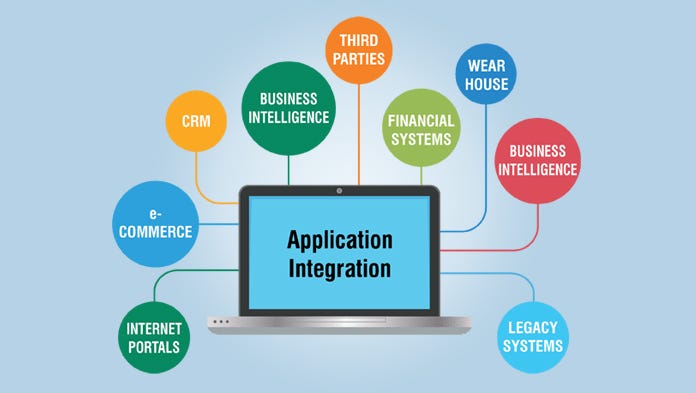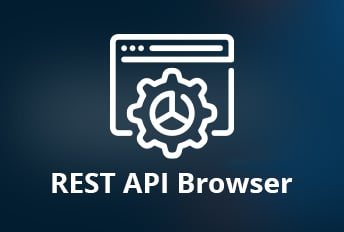
What is Application Integration? Know the Basics
There are several applications that fulfill dedicated needs and roles within businesses. Hence, instead of depending on one application, organizations use multiple applications to meet their requirements. However, handling several applications and the data within them can be challenging. This is where application integration middleware steps in.
Application integration helps you maintain, manage, and keep all your software updated while reducing data repetition and redundancy. When you create an integrated application network, all your business and work procedures can be automated and performed proficiently.
Wondering what API integration is? First, we need to define ‘integration’ and lay down the meaning of integration in the context of data warehousing. Read on to learn more.
What is Application Integration?
So, let’s define application integration. It is a process that enables the consolidation and sharing of data, resources, and processes among an organization’s applications. In other words, it is the combination and improvement of workflows and data across software applications. The end goal of this process is to enhance business efficiency. However, it particularly focuses on communicating between various enterprise systems.
Generally, the process uses middleware to transfer resources from one application to another. Without middleware, it would depend on wearisome amounts of programming and manual efforts.
Using code-free middleware with a visual UI can make your enterprise integration process more efficient, particularly when you are handling several applications. Another benefit of an integration platform is that it eliminates the need to enter data into each of your applications manually.
Common Approaches for Integrating Applications
There are two conventional approaches to enterprise application integration:
The first approach involves manually coding applications to ensure they can “talk” to one another in an understandable language.
The second method involves using an enterprise-ready integration solution that transforms and integrates data in a code-free environment. These solutions require minimal reliance on IT teams.
While both these approaches can be used, the second method is generally preferable as it is more scalable and accounts for high data volumes. Manually writing codes to integrate an increasing number of application servers can be time-consuming and error-prone.
Nonetheless, in both cases, data access, analysis, and transformation are imperative for API integration. Because if an application is unable to comprehend data from another application, inconsistencies can arise and cause delays in business processes. Hence, whichever type of application integration your organization uses, the end goal is to connect applications for analytical purposes.
Types of Application Integration
Depending on business requirements, different integration models can be implemented:
-
Data Integration: Ensures consistent data exchange between applications, databases, and cloud services. This approach eliminates data silos and enhances decision-making by synchronizing information across platforms.
-
Process Integration: Automates workflows by enabling systems to communicate with each other in real time. For example, integrating a CRM with an ERP can trigger automatic order processing when a sales deal is closed.
-
Application Interface Integration: Uses API integration best practices to enable direct communication between software applications. REST and SOAP APIs are commonly used to facilitate secure and scalable integration.
-
User Interface (UI) Integration: Combines multiple applications into a single user interface, allowing users to interact with different systems without switching between multiple applications.
Why do Enterprises Choose Application Integration?
Most companies use enterprise applications like ERPs, CRMs, and billing systems to streamline their business processes. Today, cloud-based and mobile applications offer an easy way for enterprises to execute jobs.
Let’s take a look at an API integration example to understand it better. For instance, an organization stores its customer information on Salesforce and accounting data on Oracle. Using the integration of applications, the company employees can get both sets of information combined in one place for analytical purposes.
However, these types of applications don’t always offer the most innovative solution to business problems on their own. In a scenario like this, it becomes essential for companies to leverage different system integration points. Enterprise API integration solutions can be used to integrate data between existing and new apps.

Source: Medium
Advantages of Enterprise Application Integration
Some of the main benefits of application integration are stated as follows:
1. Eliminate Data Silos
Applications designed by different vendors cannot communicate with each other without using additional technology. Integration middleware acts as a glue between various enterprise applications, whether they are on-premise or cloud. Data silos slow down business operations and prevent the effective sharing of data; as a result, it remains isolated within every system.
Using an enterprise application integration solution eliminates data silos and enables the productive use of data.
2. Faster Time-to-Market
Businesses often fail to generate a higher ROI because of delays in technology deployment. By integrating various applications, companies can fast-track their business processes, reduce time-to-market, and boost their ROI.
By utilizing API integration tools, companies can incorporate and convert data of any format to the appropriate format without any manual effort.
3. Process Automation
Depending on the industry, business procedures can diverge significantly. Enterprise application integration helps facilitate smooth data transfer among all kinds of systems and workflows to support productivity and automation.
4. Data Visibility
Application integration facilitates point-to-point integration and enhances data visibility which in turn enables businesses to observe, measure, and embrace data. Moreover, you can utilize data to effortlessly address customer expectations and acquire a broad view of business activities.
Common Challenges in Application Integration
While application integration has its benefits, such as streamlining operations and ensuring seamless data exchange, it comes with several challenges. Organizations must address these obstacles to maintain efficiency and avoid disruptions in their workflows.
1. Legacy System Compatibility
Many enterprises still rely on legacy applications that were not built for modern API integration. These outdated systems often lack the necessary connectors or interoperability features, making integration complex and resource-intensive. Using integration middleware solutions can bridge the gap between old and new applications, enabling smooth data flow without extensive redevelopment.
2. Data Silos and Inconsistencies
When applications operate in isolation, data silos form, preventing organizations from accessing unified, real-time information. Additionally, inconsistent data formats across different systems can lead to synchronization errors. Data integration techniques, such as ETL (Extract, Transform, Load) and API-based synchronization, help standardize and consolidate information, ensuring accuracy and reliability.
3. Scalability and Performance Bottlenecks
As businesses grow, so do their data volumes and integration demands. Traditional point-to-point integrations may not scale efficiently, leading to performance issues. Implementing an enterprise integration platform with built-in scalability ensures that increasing workloads and real-time data processing needs are met without compromising system performance.
4. Security and Compliance Risks
Integrating multiple applications means sharing sensitive business and customer data across different systems. Without proper security measures, integrations can expose organizations to cybersecurity threats and compliance violations. Implementing API security best practices, such as encryption, access controls, and audit logs, ensures data integrity and regulatory compliance.
5. High Maintenance and IT Dependence
Manually coded integrations require continuous updates and troubleshooting, increasing IT workload and operational costs. A low-code/no-code integration platform reduces reliance on technical teams by offering pre-built connectors and visual workflow automation, making integration management more efficient.
6. Real-Time Data Synchronization
Modern enterprises require real-time data access to make informed decisions. However, many integration solutions operate on batch processing, causing delays in data availability. Leveraging real-time API integration and event-driven architectures can enhance responsiveness and improve business agility.
Best Practices for Application Integration
A well-planned application integration strategy ensures seamless data exchange, enhances business agility, and minimizes integration challenges. By following best practices, organizations can improve efficiency, scalability, and security across their enterprise application integration initiatives.
1. Define Clear Integration Objectives
Before implementing an integration strategy, identify your organization’s goals. Are you looking to eliminate data silos, improve real-time data access, or automate workflows? Establishing clear objectives helps in selecting the right API integration platform and ensures that integrations align with business needs.
2. Choose the Right Integration Approach
Selecting between manual coding vs. enterprise integration platforms is crucial. While custom-coded integrations offer flexibility, they can be complex and require ongoing maintenance. Opting for a low-code/no-code integration platform streamlines the process with pre-built connectors, reducing IT dependency and improving scalability.
3. Standardize Data Formats and Protocols
Applications often use different data formats (XML, JSON, CSV) and communication protocols (REST, SOAP, FTP). Standardizing these elements using data integration techniques ensures seamless interoperability. Implementing a unified integration middleware solution helps transform and map data consistently across applications.
4. Prioritize Security and Compliance
As integrations involve data exchange between multiple applications, ensuring security is critical. Best practices include:
- Implementing API security best practices, such as authentication, encryption, and role-based access control.
- Using secure protocols like OAuth 2.0 and HTTPS to prevent unauthorized access.
- Ensuring compliance with industry regulations (GDPR, HIPAA) when handling sensitive data.
5. Enable Real-Time Data Processing
Many traditional integrations operate in batch mode, leading to delays in data availability. Leveraging real-time API integration and event-driven architectures enhances data synchronization and enables instant decision-making.
6. Ensure Scalability and Flexibility
As businesses grow, integration needs evolve. Using a scalable enterprise integration solution allows organizations to adapt to increasing data volumes and new applications without reworking existing integrations. Cloud-based integration platforms offer flexibility, ensuring seamless connectivity between on-premise and cloud applications.
7. Monitor and Maintain Integrations
Ongoing monitoring is essential to prevent failures and ensure smooth data flow. Implementing integration monitoring tools helps track performance, detect bottlenecks, and optimize workflows proactively. Automating error-handling mechanisms reduces downtime and improves system reliability.
How To Integrate Applications
API integration is not possible without the use of an application programming interface or API. API is the set of rules or protocols for building application software. It’s a method of communication that facilitates the interaction between applications and system software. Furthermore, it allows access to data trapped in cloud sources.
API allows flexibility and control for end-users whilst ensuring that the original creators maintain their application without any external interference. Whereas data integration involves the consolidation and migration of data into a single repository or data warehouse. This explains the difference between application integration vs data integration.
API has been long used for the integration of on-premise software systems. Nowadays, APIs are being used for different purposes, such as real-time data retrieval, system integration, system synchronization, and system updates.
AI-Driven Application Integration with Astera Data Pipeline Builder
Businesses often find it difficult to integrate several applications into their enterprise data architecture. However, application integration tools have modern technology that can help with integrating with minimal effort.
Astera Data Pipeline Builder is an AI-powered enterprise application integration tool that comes with built-in cloud and on-premise application connectors, eliminating integration challenges. The solution offers out-of-the-box connectivity and scalability your business requires, reducing integration intricacies.
Ready for a seamless application integration process? Download Astera Data Pipeline Builder’s 14-day free trial now!
 Astera AI Agent Builder - First Look Coming Soon!
Astera AI Agent Builder - First Look Coming Soon!



